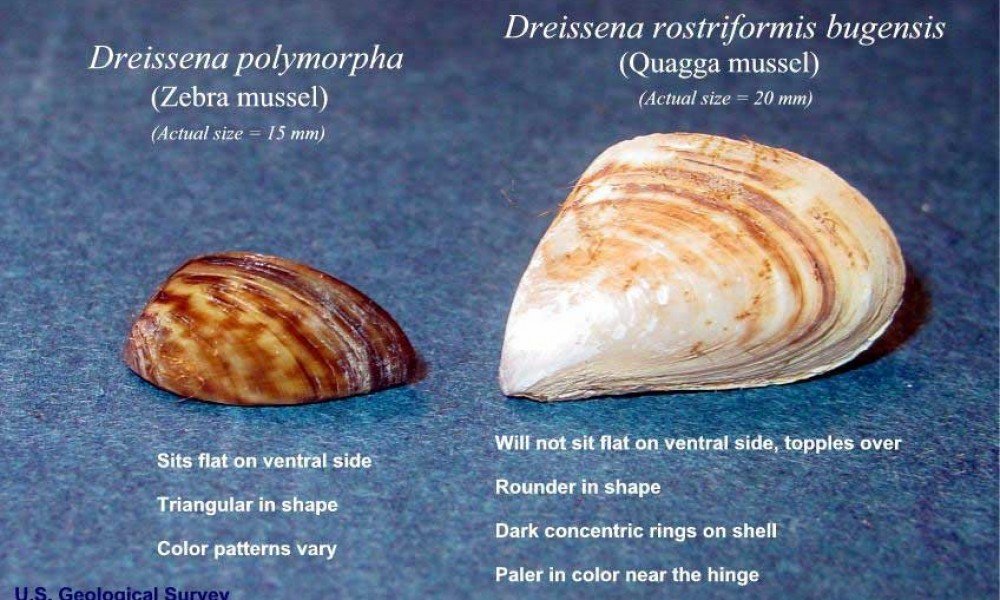Zebra Mussels (Dreissena polymorpha) and Quagga Mussels (Dreissena bugensis)
Description
Zebra and quagga mussels are bivalve, filter feeders that negatively affect water related economies and can wreak havoc on aquatic ecosystems. They very similar species that were once considered the same. However, genetic analysis has determined them to be two distinct species. Anatomically they share shell coloration (black, white, or both), striation, and size (2.3-2.5cm) but have differing shell shape. A quagga mussel's ventral side is convex with the ventral lateral margin lacking an acute angle; while a zebra mussel's ventral side is typically flattened with an acute lateral-ventral angle. Simply if a quagga mussel is placed on their ventral side they would topple over whereas a zebra mussel would remain upright on its ventral side.
Additionally the life cycle of the D. polymorpha and D.bugensis are analogous, varying with size and time in the specific developmental phases. Both species have two major life stages: planktonic larval and sessile, dioecious adult. D. polymorpha and D.bugensis for the most part occupy two different niches, which allow them to initially coexist at depths from 8-110 meters. Zebra mussels are most notably associated with a firm attachment to hard substrates because their D-shape and byssal threads. However ten years after the initial colonization of zebra mussels, Berkman et al. (2000) has found populations on softer strata (sand, silt, mud) adjacent to the original hard strata colony. On the other hand quagga mussels are more associated with soft substrates and deeper, cooler waters (found at depths of 130m), but more frequently quagga mussels have been displacing zebra mussels from the rocky littoral zone within 4-12 years after their establishment.
Native Range and Distribution
Native to parts of Europe, Zebra and Quagga mussels have been transported to the Great Lakes basin by ballast water discharge from transoceanic vessels. The zebra mussel is native to waterways of southern Russia, and has been established in North America at St. Clair Lake since 1989. As of 1991 the quagga mussel, native to the Dnieper River drainage of Ukraine, has been found in the Erie Canal and Lake Ontario. Within a few years after initial colonization, the two have spread quickly throughout the Great Lakes, Finger Lakes, St. Lawrence River, the Mohawk and Hudson River drainages (Mills et al., 1996). Since the mid-1990s zebra mussels have been established on the edges of the Adirondack Park in Lake Champlain and Lake George. Quagga mussels have yet to reach the inner boundaries of the Park but thrive in waters closely surrounding. Both of these species' life cycle, high fecundity, and microscopic veliger stage allow for easy dispersal and establishment within and between water bodies. However, their ecological requirements, like calcium concentration, could help keep zebra and quagga mussels from successfully establishing and becoming a nuisance in the some Adirondack waterways.
Threats and Impacts
Dreissenids' filter-feeding life style and large populations of up 750,000 individuals per square meter can have many impacts on an aquatic ecosystem. They directly displace indigenous bivalve communities by outcompeting them for habitat and nutrients. Not only do they destroy native mussel (Unionoida) populations, but they also effect water quality and lower trophic levels. Due to their incredible filtering capability, dreissenids can significantly increase water clarity. The increased water clarity can be misleading because zebra and quagga mussels are essentially concentrating the nutrients in the sediment or benthic regions. The sediment confined nutrients can easily re-suspend in turbid/shallow areas and lead to phytoplankton/cyanobacteria blooms, an increased trophic state, and decreased water quality. Additionally, zebra and quagga mussels' intermediate filtration rates result in dense populations excreting large amounts of dissolved nutrients, especially nitrogen in the form of ammonia. This excess defecation may supply limiting nutrients to benthic primary producers and can lead to dissolved oxygen depletion
Not only do these invaders change water chemistry and aquatic habitats, but they also cost industry billions of dollars a year in lost production and management. Since they can form thick denisities, the greatest economic damage is caused by the fouling and clogging of pipes, pumps, boat hauls, or other components of municipal or industrial water systems. Particularly, impacted facilities and economies have included municipal drinking water systems; hydroelectric power plants; water flow/level control facilities; irrigation systems; navigation equipment (buoys, locks); and lowered realestate values. Additionally the tourism industry may be impaired by the masses of shells on beaches and swimming areas that can cut recreationalists.
Management
The impacts on the environment and industry caused by zebra and quagga mussels have resulted in mitigation efforts. Once established there are control options that can be implemented to manage and potentially eradicate quagga and zebra mussel populations. In Lake Mead, Nevada/Arizona the DSBCP (2008) reviews different methods for eradication/control:
•Water level manipulation
• Isolate with barriers or coverings and then treat with effective biocide such as potassium chloride, copper sulphate, and sodium hypochlorite.
• Benthic mats
• Use of heat, chemical, and mechanical removal on biofouled intake pipes or other equipment
• Antifouling coating in the form of TBTO (tributyl tin oxide, an organotin oxide), copper, or nontoxic silicone based coating
All of these methods come with a huge cost, and preventing quagga and zebra mussel from establishing pestiferous growths is the only way to eliminate the negative impacts on the environment and industry.
Additional Information on Zebra/Quagga Mussel
Zebra/Quagga Mussel Literature Review by Adirondack Watershed Institute

